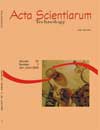<b>Chemical composition of fresh and frozen storage freshwater fish</b> - DOI: 10.4025/actascitechnol.v28i2.1167
DOI:
https://doi.org/10.4025/actascitechnol.v28i2.1167Keywords:
proteínas, lipídios, peixes de água doce, estocagem sob congelamentoAbstract
The chemical composition of four freshwater fish species (common carp, “pacuâ€, “piauaçu†and Nile tilapia) was investigated. The fish was immediately analyzed after the catch and at different times of frozen storage (60, 120 and 180 days), with skin or without skin. The species constitute good protein sources, with values between 14.51 and 16.98%. “Pacu†and “piauaçu†presented the highest lipid content (16.83 and 14.43%, respectively) thus classified as fatty species, while the common carp and the Nile tilapia, as lean species (4.86 and 1.27%). There was significant reduction of lipid content after skin removal of the analyzed fish (42.652%). The protein percentage raised (7.72%) with the removal of skin at the extent of storage time with few exceptions. During frozen storage at 60 and 180 days there was a decrease in the lipid content of the common carp (34.02%), “pacu†(41.23%) and “piauaçu†(14.86%). During the 180 days storage, the protein content decreased in the fish samples classified as fatty (6.09%). The opposite happened with the lean species (increase of 14.32%). Therefore, length of frozen storage time and the removal of skin should be considered during the evaluation of fish chemical composition due to the alteration in the edible muscle componentsDownloads
Download data is not yet available.
Downloads
Published
2008-03-20
How to Cite
Guinazi, M., Moreira, A. P. B., Salaro, A. L., Castro, F. A. F. de, Dadalto, M., & Pinheiro-Sant’Ana, H. M. (2008). <b>Chemical composition of fresh and frozen storage freshwater fish</b> - DOI: 10.4025/actascitechnol.v28i2.1167. Acta Scientiarum. Technology, 28(2), 119–124. https://doi.org/10.4025/actascitechnol.v28i2.1167
Issue
Section
Chemistry
License
DECLARATION OF ORIGINALITY AND COPYRIGHTS
I Declare that current article is original and has not been submitted for publication, in part or in whole, to any other national or international journal.
The copyrights belong exclusively to the authors. Published content is licensed under Creative Commons Attribution 4.0 (CC BY 4.0) guidelines, which allows sharing (copy and distribution of the material in any medium or format) and adaptation (remix, transform, and build upon the material) for any purpose, even commercially, under the terms of attribution.
Read this link for further information on how to use CC BY 4.0 properly.











8.png)




